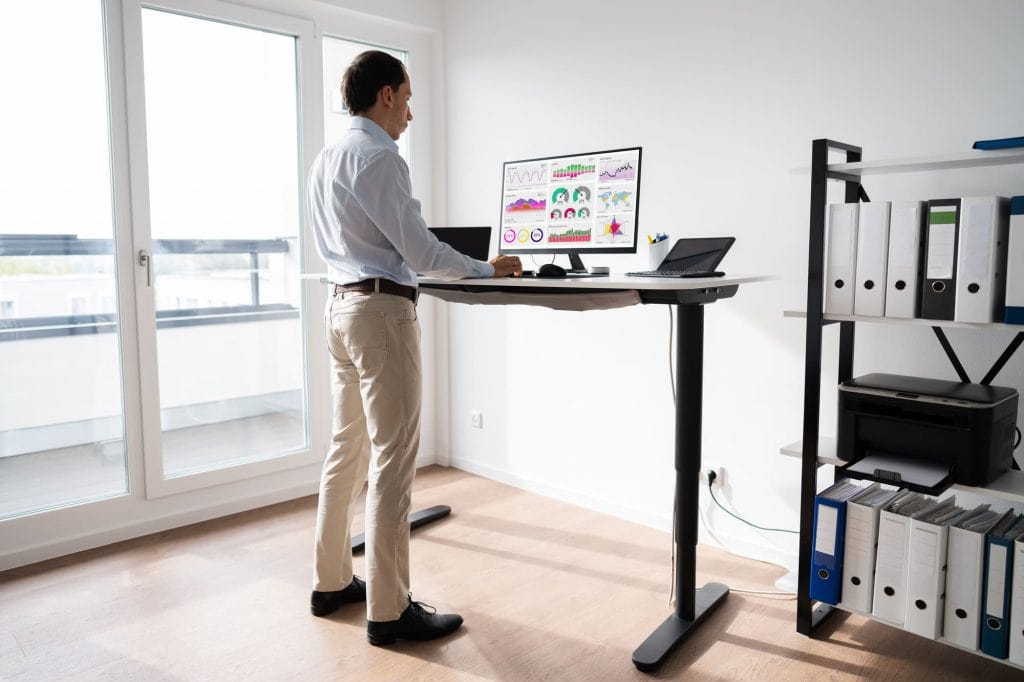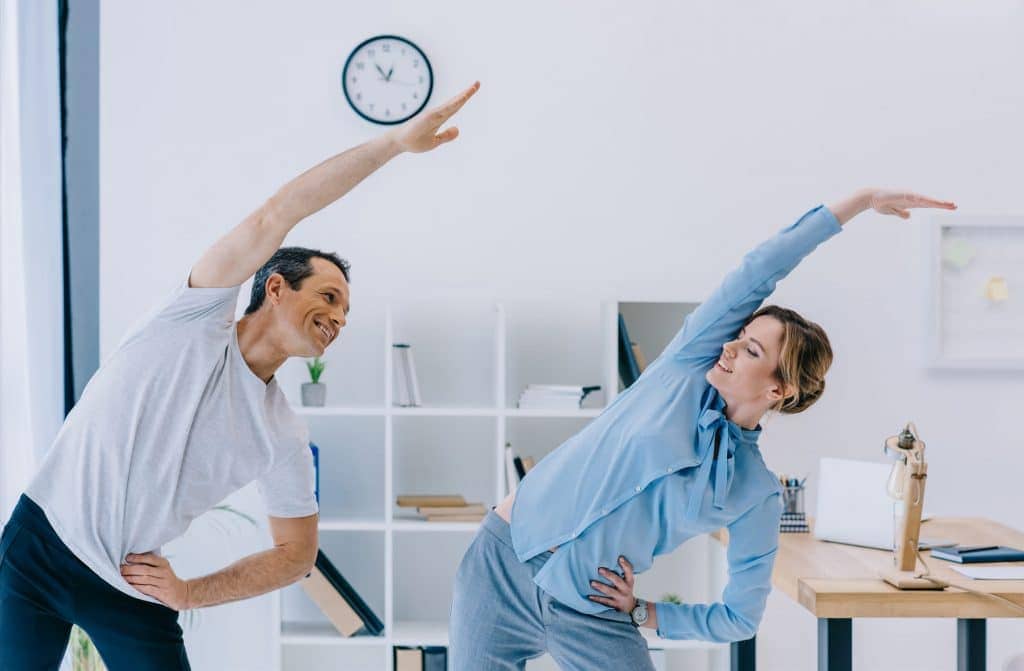*When you buy through links on our site, we may earn an affiliate commission at no additional cost to you.
Getting used to a standing desk is a process. Most beginners have had their share of problems when using a standing desk.
Some use it for so long that they end up with swollen legs. Others feel fatigued after using it for just a few days.
The secret to getting used to it is learning how to use a standing desk correctly. You need to know how to set it up correctly, how long to stand at it, etc. All this is crucial to accelerating you to get used to your standing desk.
In the guide below, we’ll walk you through some helpful tips to help you get quickly accustomed to your new sit-stand desk and reap all its benefits.
Table of Contents
9 Tips for standing desk users to get used to standing desks
The biggest SECRET to getting used to your new standing desk is learning to use it correctly. The following tips will usher you into a standing desk and help you get accustomed to it much faster—in weeks!
#1. Adjust the standing desk properly
One of the biggest mistakes beginners make with their sit-to-stand desks is using them without first setting them to a comfortable height.
There’s a reason these desks are height adjustable, whether you’re using a desk riser or a full height adjustable desk. This gives you a wide range of height settings to help different users choose the most comfortable and ergonomic standing height.
Now, you may ask how you can set your standing desk height correctly.
It’s pretty simple…you just need to bring your desk up at about your elbow height. This means that your elbows should be at around 90 degrees relative to the floor.
Standing desks don’t have a one height fits all.
They’re adjustable, so you can raise or lower them to a comfortable height depending on your body size.
If you’re an average person with a height of 5’11”, you should set your desk at around 44 inches high for comfortable standing.
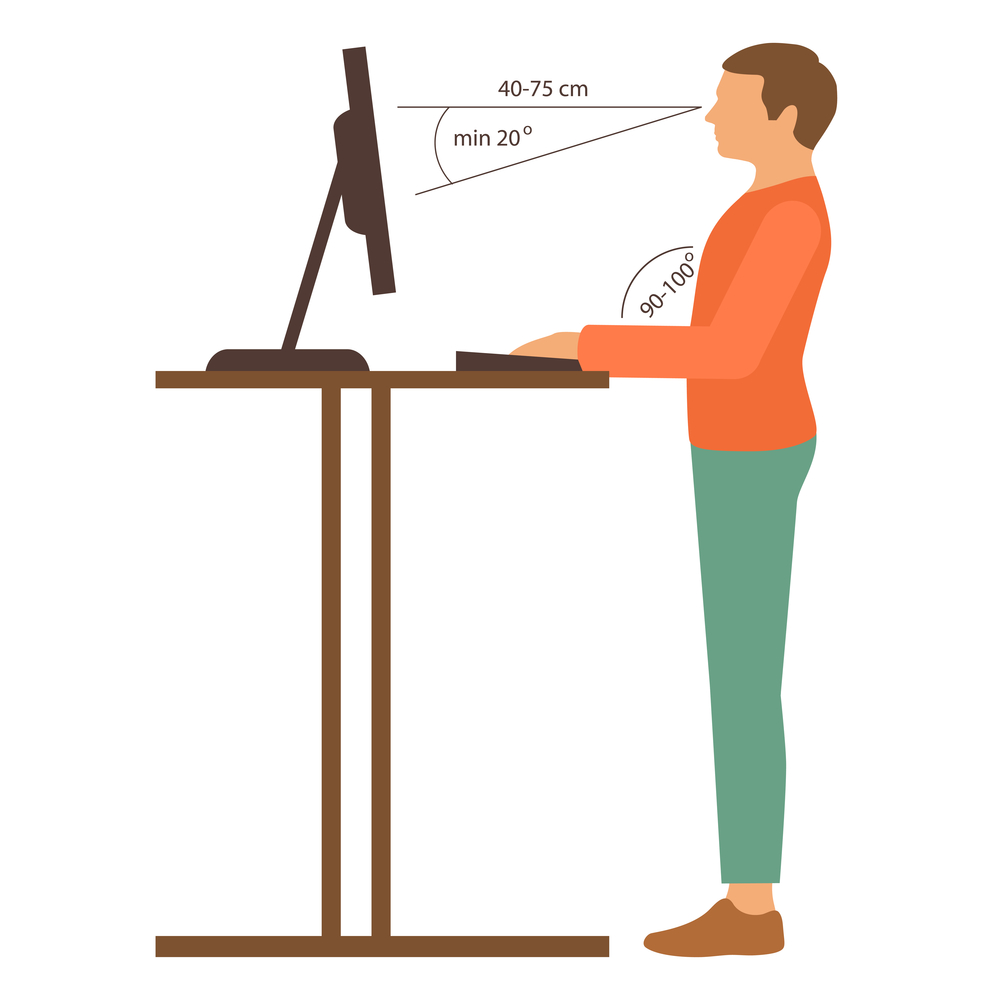
Consider saving your favorite heights if you’re using an electric standing desk with the memory function. This way, you’ll just need to press a button next time you want to set your favorite standing height.
#2. Set the monitor to an ergonomic height
Apart from setting your desk height correctly, you’ll need to place your computer screen height to a comfortable viewing position.
The best way to set your screen is to ensure its top is at your eye level. This level will enable you to view it without straining your neck. A small tilt of around 10-20 degrees further ensures you don’t keep tilting your neck up and down to view the screen.
Besides the height, you should also make sure the screen sits at a comfortable distance from you. Experts recommend setting the monitor at around 20-28 inches from your face.
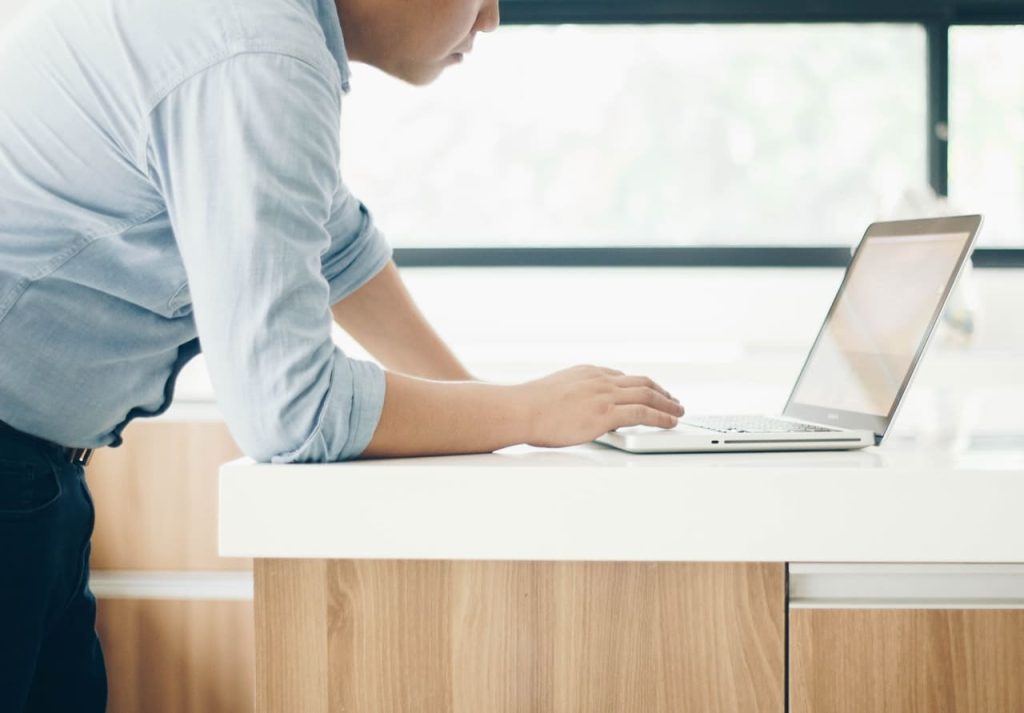
If you’re using a laptop, we advise you to get an external keyboard and mouse. This will allow you to raise the laptop to eye level for comfortable viewing.
Using the laptop on a standing desk without boosting its height will force you to tilt the screen back. This will also cause your neck to stay back—not good for long-term use and will lead to user discomfort.
#3. Alternate between sitting and standing
Another helpful habit that will help you get used to standing desks is regularly alternating between the sitting and standing positions.
When most office workers first get a standing desk, they’re too excited that they end up trying to stand at it for long hours.
However, this is a huge mistake that often leaves you with swollen legs, foot pain, and muscle fatigue. You can also lose focus if you stand for long hours.
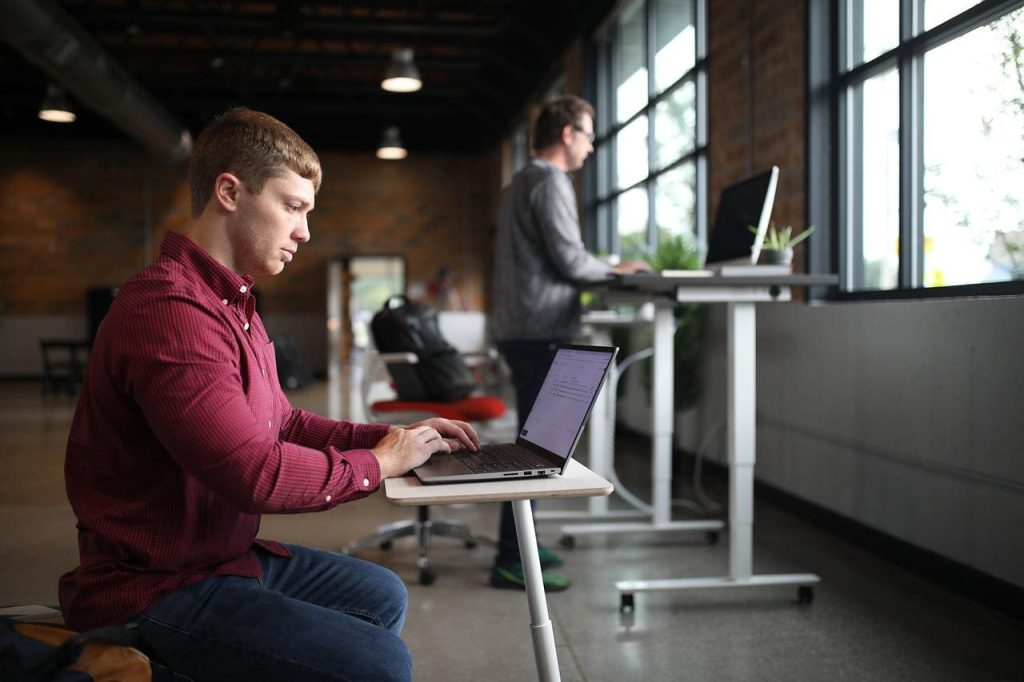
Spending extended hours in the standing position can cause lower back pain, just like too much sitting, and varicose veins.
Luckily, you can avoid these health problems by standing for long periods of time and then switching to sitting.
Research on the right amount of time to use a standing desk is still being conducted. But we suggest doing it in the ratio of 1:1 or 1:2 (i.e., for every 1 hour you stand, switch to sitting for 1-2 hours).
For an absolute beginner, try using your desk for approx. 30 minutes to give your body time to get used to this new working position.
#4. Get your posture right!
Standing with good posture is another secret to help you use a standing desk correctly.
A bad posture will make you hunch over your desk and get fatigued quickly. You’ll have a bad experience with your desk.

This is how you stand straight and correctly at your standing desk:
- Keep your feet shoulder-width apart
- Make sure your rib cage is above your hips so you’re not leaning backward or forward
- Put your knees straight and not locked. Some standing desk users tend to tighten their knees, making them bent too far in the wrong direction. This can lead to strain in your lower back.
- Keep shoulders relaxed and rolled back (i.e., they’re not too far back or hunched forward). On top of this, your chest should be rolled out to help bring out the natural spine S-curve.
- Above all, put your chin up and the head straight (not tilted forward).
If someone looks at your side, they should see your ears over your shoulders.
Also read, what happens if your desk is too high.
#5. Put an anti-fatigue mat under your desk
It’s normal to get fatigued quickly when you start using your desk. This can derail the process of getting used to your new workstation. However, you can beat this by putting an anti-fatigue mat under your desk.
Unlike the hard floor, you’re stepping on, using a standing desk mat offers you some extra cushioning, which helps take pressure off your feet and ankles.
This enables you to stand for extended periods without fatigue.
These anti-fatigue mats also promote micro-movements that ensure you stay active throughout your standing sessions—promoting blood flow and reducing human body discomfort.
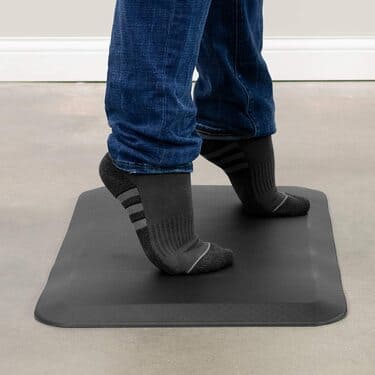
#6. Take breaks from your sit-stand desk
When you start using a stand, alternating between sitting and standing isn’t enough. You should take regular breaks from this desk to move around or even stretch. This is a great hack to reduce the time you spend standing.
Taking short walks before transitioning from standing to sitting can help clear your mind and prepare you for the next session of working while sitting. Short walks, whether around your office or outside, can significantly affect your mood and increase productivity.
Taking breaks will come naturally and won’t be a problem for some people. Others will, however, need a reminder.
When you’re getting started, you may forget to take breaks. That’s why it’s important to set a timer (you can install software on your PC or use an app on your phone to remind you when it’s time to break).
With time, you’ll get used to taking breaks, and it will come naturally without any reminders.
#7. Do standing desk stretches
So, you’re taking breaks from your standing desk as we have advised above? But what exactly would you do during that break? Walking is one thing.

Another equally helpful activity is doing some standing desk exercises or stretches.
These are pretty simple to do; you can do them right in front of your standing workspace, and you won’t need any special exercise equipment.
#8. Wear good shoes
The type of shoes you wear can significantly influence your relationship with a standing desk.
For instance, wearing high heels when standing at your desk for long hours can cause knee pain and hip problems.
Wear good, supportive shoes to feel comfortable standing in for hours.
Get a pair of comfortable shoes specifically for use when using a standing workstation. Ensure the pair fits you and offers good support to your feet and ankles.
#9. Introduce armrests
Armrests are inexpensive accessories that you attach to your workspace for added comfort. These are typically soft padded surface areas and easily attach to your desk.
Their job is to help take pressure off your wrist as you operate your mouse.

Mind you, studies have already been conducted around the arm support. The results showed that they can help significantly reduce the risk of developing shoulder and neck problems.
This is especially helpful on the side of the hand you use to operate the mouse (the dominant hand).
Final Thoughts – How To Use And Get Used To A Standing Desk
When you start using your new standing desk for the first days, you might feel like it’s not for you and even want to quit. This is perfectly normal and happens to nearly all beginners.
The important thing is to learn how to use your standing desk correctly. This way, you’ll have a comfortable experience using your standing workspace, and you’ll get used to it sooner.
We have just shared some crucial tips that will help you use your standing desk properly and avoid the common mistakes beginners make.
Follow these practices religiously, and they will accelerate you on your path to getting used to sit-stand desks.

